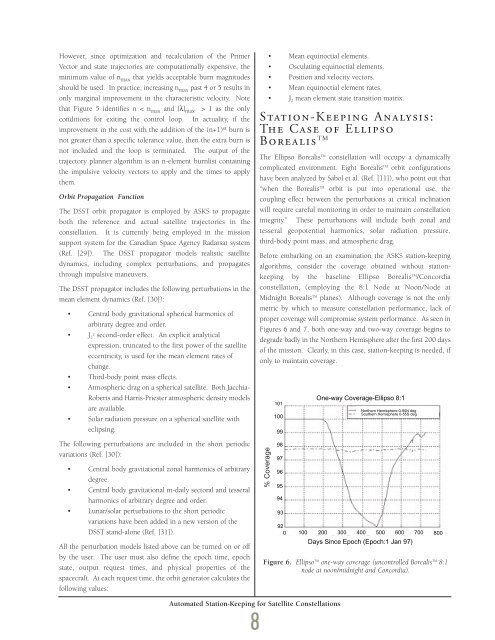1998 - Draper Laboratory
1998 - Draper Laboratory
1998 - Draper Laboratory
- No tags were found...
Create successful ePaper yourself
Turn your PDF publications into a flip-book with our unique Google optimized e-Paper software.
However, since optimization and recalculation of the PrimerVector and state trajectories are computationally expensive, theminimum value of n max that yields acceptable burn magnitudesshould be used. In practice, increasing n max past 4 or 5 results inonly marginal improvement in the characteristic velocity. Notethat Figure 5 identifies n < n max and |λ| max > 1 as the onlyconditions for exiting the control loop. In actuality, if theimprovement in the cost with the addition of the (n+1) st burn isnot greater than a specific tolerance value, then the extra burn isnot included and the loop is terminated. The output of thetrajectory planner algorithm is an n-element burnlist containingthe impulsive velocity vectors to apply and the times to applythem.Orbit Propagation FunctionThe DSST orbit propagator is employed by ASKS to propagateboth the reference and actual satellite trajectories in theconstellation. It is currently being employed in the missionsupport system for the Canadian Space Agency Radarsat system(Ref. [29]). The DSST propagator models realistic satellitedynamics, including complex perturbations, and propagatesthrough impulsive maneuvers.The DSST propagator includes the following perturbations in themean element dynamics (Ref. [30]):• Central body gravitational spherical harmonics ofarbitrary degree and order.• J 22 second-order effect. An explicit analyticalexpression, truncated to the first power of the satelliteeccentricity, is used for the mean element rates ofchange.• Third-body point mass effects.• Atmospheric drag on a spherical satellite. Both Jacchia-Roberts and Harris-Priester atmospheric density modelsare available.• Solar radiation pressure on a spherical satellite witheclipsing.The following perturbations are included in the short periodicvariations (Ref. [30]):• Central body gravitational zonal harmonics of arbitrarydegree.• Central body gravitational m-daily sectoral and tesseralharmonics of arbitrary degree and order.• Lunar/solar perturbations to the short periodicvariations have been added in a new version of theDSST stand-alone (Ref. [31]).All the perturbation models listed above can be turned on or offby the user. The user must also define the epoch time, epochstate, output request times, and physical properties of thespacecraft. At each request time, the orbit generator calculates thefollowing values:• Mean equinoctial elements.• Osculating equinoctial elements.• Position and velocity vectors.• Mean equinoctial element rates.• J 2 mean element state transition matrix.Station-Keeping Analysis:The Case of EllipsoBorealis TMThe Ellipso Borealis TM constellation will occupy a dynamicallycomplicated environment. Eight Borealis TM orbit configurationshave been analyzed by Sabol et al. (Ref. [11]), who point out that“when the Borealis TM orbit is put into operational use, thecoupling effect between the perturbations at critical inclinationwill require careful monitoring in order to maintain constellationintegrity.” These perturbations will include both zonal andtesseral geopotential harmonics, solar radiation pressure,third-body point mass, and atmospheric drag.Before embarking on an examination the ASKS station-keepingalgorithms, consider the coverage obtained without stationkeepingby the baseline Ellipso Borealis TM /Concordiaconstellation, (employing the 8:1 Node at Noon/Node atMidnight Borealis TM planes). Although coverage is not the onlymetric by which to measure constellation performance, lack ofproper coverage will compromise system performance. As seen inFigures 6 and 7, both one-way and two-way coverage begins todegrade badly in the Northern Hemisphere after the first 200 daysof the mission. Clearly, in this case, station-keeping is needed, ifonly to maintain coverage.% Coverage10110099989796959493One-way Coverage-Ellipso 8:1Northern Hemisphere 0-90N degSouthern Hemisphere 0-55S deg920 100 200 300 400 500 600 700Days Since Epoch (Epoch:1 Jan 97)Figure 6. Ellipso TM one-way coverage (uncontrolled Borealis TM 8:1node at noon/midnight and Concordia).800Automated Station-Keeping for Satellite Constellations8
















